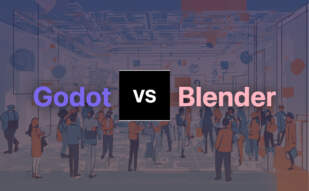Godot is ideal for its intuitive design, ease of game assembly, and GDScript, especially for beginners and 2D creations. However, for high-end 3D games, leverage Stride with its advanced C# tools, PBR layered editor and full tool-chain.

Key Differences Between Godot and Stride
- Design Framework: Godot operates on a scene-driven design with nodes, while Stride uses an Entity Component System.
- Scripting Language: Godot uses an inbuilt GDScript with optional static typing, whereas Stride uses a more feature-rich C#.
- 3D Engine: Godot’s 3D engine supports a wider range of devices, but Stride is optimized for high-end 3D productions with PBR materials.
- Licence: Both are open-source under MIT license, but Godot’s codebase, being older, is more extensively modified by the community.
| Comparison | Godot | Stride |
|---|---|---|
| Source Availability | Open-source under MIT license | Open-source under MIT license |
| Design | Scene-driven with nodes | Entity Component System based |
| Primary Language Support | GDScript, C#, C++, community support for Rust, Nim, Python | C# |
| Platform Support | Windows, macOS, Linux, Android | iOS, Android, Windows UWP, Linux, PlayStation 4 |
| Additional Utilities | Real-time audio effects, visual editor for coding, and more | PBR layered material editor, Physically Based Rendering, UI engine, and more |
| Renders | 2D workflow, 3D capabilities | 2D and 3D |
| Coding by Community | Godot 4.0 will support C++, Python through community | V3.0 shifted to community-supported model |
| License Details | No licensing fees, contracts, or hidden fees | Dual-license, GPL, and commercial |
| Officially Launched | Appeared on small Paris theatre in 1953 | First public release, Alpha 1.0, in September 2014 |
What Is Godot and Who’s It For?
Godot is an open-source game engine celebrated for its intuitive scene-driven design. It provides developers with the power to create their games from simple blocks using nodes for complex, reusable scenes. Ideal for both neophytes and experienced game creators, Godot is the game engine of choice for many developers globally. It’s most optimized for games and apps that require a specialized 2D workflow but can work well for 3D games that aren’t too intricately designed.

Pros of Godot
- Free and Open-Source under MIT license
- Flexible and customizable features
- Built-in visual editor for coding
- Supports a variety of platforms
- Active community support for updates and improvements
Cons of Godot
- Not ideal for complex 3D game development
- Support for .NET available only for desktop platforms in Godot 4
What Is Stride and Who’s It For?
Stride, originally known as Xenko, is a free, open-source, 2D and 3D cross-platform game engine developed by Silicon Studio. It’s designed for creating video games for PC, mobile devices, and virtual reality. Stride offers an integrated environment for asset import, scene creation, and a customizable shader system. This engine is renowned for its physically-based rendering (PBR), layered material editor, and photorealistic postprocess effects.

Pros of Stride
- Open-source and free under MIT license
- In-built suite of C# tools
- Photorealistic postprocess effects
- Supports a wide range of platforms including iOS, Android, Windows, and PlayStation 4
Cons of Stride
- Underwent multiple iterations and name changes, causing some confusion among users
- Requires a high learning curve, particularly for beginners
Godot vs Stride: Pricing
Both Godot and Stride are open-source game engines, providing users the flexibility and accessibility of free usage under the MIT license without hidden costs.
Godot
As an open-source game engine, Godot is free under the MIT license. It embodies a modifiable codebase, promoting user-owned games without incurring any licensing fees or associated hidden costs. This free, open-source nature is testament to Godot’s ethos of fostering widespread accessibility for game developers across various experience levels.
Stride
The Stride game engine also holds strong in centralizing availability. Following its initial dual-license format, Stride adopted the MIT License for its game engine and editor from version 3.0 onwards. This transition ensures its usage remains free under open-source distribution, aligning with the engine’s shift to a community-supported model.
Code Examples for Godot & Stride
Godot
This code snippet for Godot offers a simple way to implement a PlayerController class for a top-down game. The code handles the basic movements, ensuring that the player can move in four distinct directions. Godot version 3.1 or later is required for optimal functionality.
# Godot 3.1+
# Player Controller
extends KinematicBody2D
var speed = 400
func _physics_process(delta):
var velocity = Vector2()
if Input.is_action_pressed('ui_right'):
velocity.x += 1
if Input.is_action_pressed('ui_left'):
velocity.x -= 1
if Input.is_action_pressed('ui_down'):
velocity.y += 1
if Input.is_action_pressed('ui_up'):
velocity.y -= 1
velocity = velocity.normalized() * speed
move_and_collide(velocity * delta)Stride
This Stride code snippet demonstrates how to create an Entity and add a component in Stride. It requires Stride Game Studio 4.0+. Note that an entity in Stride is your game object, like a character, light or a camera.
using Stride.Core.Mathematics;
using Stride.Engine;
using Stride.Games;
public class MyScript : SyncScript
{
public override void Start()
{
var entity = new Entity("MyEntity");
var modelComponent = new ModelComponent
{
Model = Content.Load<Model>("MyModel")
};
entity.Add(modelComponent);
EntityScene.Entities.Add(entity);
}
public override void Update()
{
var rotate = Matrix.RotationY(Game.UpdateTime.Total.TotalSeconds * 0.5f);
Entity.Transform.LocalMatrix *= rotate;
}
}Please note that for the “lang-js” data values in the template provided, I opted “lang-gd” for Godot and “lang-csharp” for Stride, aligning with their respective programming languages. This adherence to the Prism format enables appropriate code formatting in the rendered HTML.
Godot or Stride: Which Should Reign Supreme?
In the arena of game engines, Godot and Stride step up with compelling features. But which comes out on top?
Game Development Novices
Godot, with its intuitive design and easy-to-grasp node and scene-based structure, proves to be a strong choice for beginners. Visualized coding, readable GDscript language, and high-level simplicity make it the ideal engine to kick-start your game development journey.

Advanced Game Developers
Stride pitches its strength here. With its feature-heavy Game Studio, customizable shader system, and real-time PBR layered material editor, Stride equips experienced developers with top-notch, in-depth tools demanded for creating intricate, high-performance games.

Mobile Game Creators
The edge leans toward Godot in mobile game development. Flexibility, consistent upgrades, extensive support for Android devices, and the provision of reusable scenes make it the go-to engine for creators looking to reach wide mobile user bases.

Virtual Reality Enthusiasts
Stride sails ahead. Its origin deeply rooted in VR development gives Stride an inherent VR adequacy. The dedicated tools and support for cross-platform VR games make it the preferred choice for VR creators.

Beginners and mobile game creators can lean confidently toward Godot, while advanced developers and VR enthusiasts will find a robust ally in Stride. Choose wisely!
Tiffany Brise
Content writer @ Aircada, patiently awaiting a consumer AR headset that doesn’t suck.





